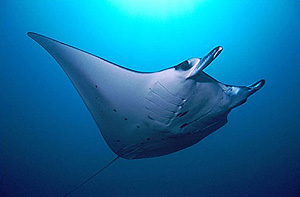 Often described as a gentle giant of the sea, the manta ray commonly inhabits areas between southern NSW and the tip of Cape York, as well as Ningaloo Reef off Western Australia. They are also found in tropical waters throughout the world.
Often described as a gentle giant of the sea, the manta ray commonly inhabits areas between southern NSW and the tip of Cape York, as well as Ningaloo Reef off Western Australia. They are also found in tropical waters throughout the world.
These graceful, saucer-like creatures are extremely agile, being able to move at rapid speed while often breaching the water in spectacular fashion. They are also known to commonly inhabit ‘cleansing stations’, (where wrasse, remora and angelfish remove parasites) found in and around the Great Barrier Reef, and Ningaloo Reef Western Australia.
Unlike its cousin the stingray, manta rays don’t contain a barb, and have the largest brain to body ratio of any Elasmobranchs (sharks, rays and skates). The largely solitary manta ray is also known to travel large distances, scouring the ocean for food such as plankton and fish larvae.
Being a filter feeder, the manta ray strains water through its gills as they swim, and often glides in vertical loops during meal times. This, it is thought, is to concentrate plankton numbers for greater feeding efficiency.
In courtship, female manta rays are tailed by several males before arcing into graceful looping motions while the males follow suit. Such behaviour has been filmed off Lady Elliot Island in the Great Barrier Reef.
Copulation is believed to occur at no more than one metre in depth, with the event thought to be facilitated by a full moon. Eggs hatch inside the female internally, so she bears live young, typically 1-2 pups.
The first historical record of this enigmatic sea-glider is in Peruvian culture, where the Moche people worshipped the manta ray. While little is known regarding the manta ray’s lifespan and travelling behaviour, the closely related warm-water ray is known to live 25-years, and one manta ray is documented as being 24-years-old.
In cultures across the world, the manta ray is valued for its properties in traditional medicine. This has unfortunately lead to unsustainable fishing practices in developing countries within Africa and South East Asia, and the IUCN (International Union for Conservation of Nature) has listed them as ‘vulnerable to extinction’. They are not currently protected in Australian waters.
Hot-spots for viewing manta rays are in and around the Great Barrier Reef. Tours to the Great Barrier Reef pickup and dropoff from Thala Beach Lodge.
